As a freelancer, what system do you use to invoice your clients?
By postal mail? By phone? Paypal? What about pigeon carrier?
Client Invoicing
When I first started working as a freelancer, I had no idea of the best or most efficient way to send invoices to my clients. I would generally create an invoice with my desktop publishing software (remember Wordperfect?), print the invoice, address and stamp the envelope and then mail it. For the next 4 weeks after that mailing, I’d stalk the postman every day until the check arrived.
I’m glad those days are over. Not only was the whole system a big hassle to deal with but the end of year tax time became an even bigger hassle. I’d have to manually track each and every invoice that was billed throughout the year, including expenses, and then plop those numbers into my tax forms. Needless to say, I absolutely dreaded the entire billing process. But as a freelancer, it was a necessary means to an end…and that end was to get paid.
Over the years since then, I’ve used various other billing systems and mechanisms:
PayPal
Probably one of the most widely-used methods, especially with internet marketers. You can do one-off invoices for clients whose billing amounts change from month to month. You can also do subscription invoicing for clients who are billed the same amount monthly.
Postal Mail
There are some clients who still don’t like digital billing and prefer for you to mail the invoice to them.
Email Billing
Clients can send wire transfers directly to your bank account. This can be a costly method for the client, and may cause them to alter your billing rate to offset this expense for their records.
Enter FreshBooks
At the end of 2013, I decided to start using FreshBooks invoicing system, mainly because a client of mine suggested it as they were using it for their own internal tracking systems. Although at first glance it didn’t really look like something I needed, I decided to give it a try anyway. Honestly, I’m glad I made the switch over to using it. I wonder now why I didn’t switch sooner.
The initial thing I liked about FreshBooks was its clean, simple-looking front-page customer interface because I’m not a big fan of too much color or busy graphics. I was also quite pleased with how simple the navigation was. The top of the front page tells you right away what you can expect from their system:

The reason why I’m pointing this out is because the 1st and the 3rd teasers caught my eye since those are the things that I was most interested in having. With my old way of doing things, I was spending way too many precious, non-billable hours creating invoices and WAY too much time waiting to get paid. I’ll talk more later about “getting paid faster” and why I’m glad I switched.
Anyway, as you go further down the landing page, you’ll see more teasers about the benefits of using FreshBooks. Of course, you’ll have to decide which benefits you need most to determine if it’s right for you, but here are some of the things they list; I’ve bolded the features that I really like:
- Save Time Billing
- Grow Your Business
- Get Paid Faster
- Send invoices in seconds
- Accept credit cards
- Multi-currency invoicing
- Late payment reminders
- Know when your invoice is viewed and paid
- Log (can use your picture camera phone), organize, import and track your billing expenses
- Team tracking and management
- Imports easily to Quickbooks (a tax timesaver!)
As a plus, their invoicing system also integrates with these other business applications:
Paypal Stripe Google Apps Zen Payroll Fundbox Mailchimp
But another feature that immediately caught my eye was the “try it free for 30 days” offer, which I jumped on right away! Any good company knows to offer a free trial if you want to get the customers hooked.
Now let’s get on to the meat-and-potatoes of this invoicing system and why I prefer it as a freelancer.
FreshBooks Customer Set-Up
Set up multiple clients
The first 3 clients you set up is at no charge (great!), so the invoicing service is essentially free if you’re only managing 1 or 2 clients. You can refer to Jon Loudon’s blog post to see how to to create an invoice. He goes into detail about each step and he was just as impressed with the product as was I!
As for my own freelance business, I currently have two large clients that I run through the FreshBooks system because they’re physically located in different countries. I’m going to eventually add in my other clients one at a time so I can plan and budget accordingly. Right now they are invoiced directly through my standard Paypal account and I want to give the clients advanced notice before I switch them over.
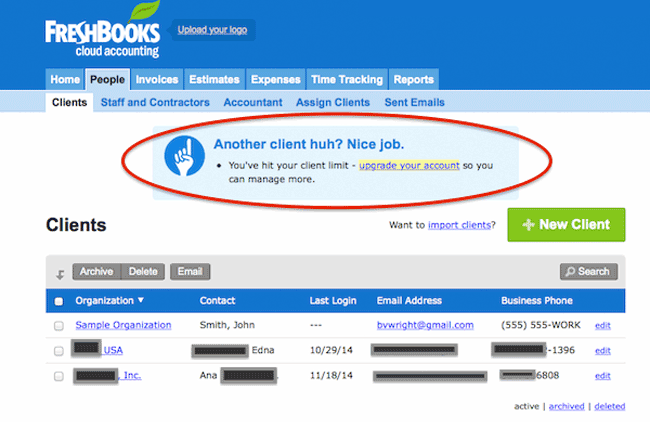
Once you’ve gone past the 3 clients, you can select a billing plan that better fits your business needs. The limit on the amount of invoices you can send, the ability to assess late fees on invoices, team tracking and other features is lifted once you get into a billing plan.

<
Billing preferences
I like that FreshBooks lets me choose whether to bill my clients through regular postal mail, by email or by BOTH. With having clients in other countries, I really didn’t have a total comfort level in mailing my invoices off and trusting them to arrive without error. I’ve dealt too much with having to mail, then re-mail, then mail invoices again because a client never received them or they went to the wrong department(s).
I’ve actually used the option to email and snail mail my clients just so I know that multiple methods were used. Although my clients don’t object to this, I ask which method they prefer for their own internal systems.
Snail mail
The snail mail feature really impressed me because FreshBooks actually sends out your invoices, in an envelope and stamped. All I had to do to use this feature was purchase stamps through them, which I would have had to do anyway, right?
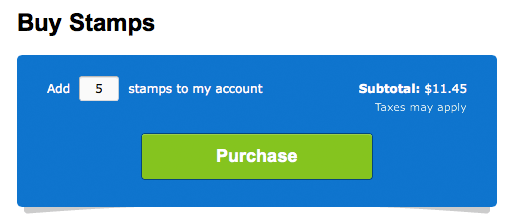
You can purchase stamps in bulk (they are a little pricier than going to the post office), and they don’t “expire” if you don’t use them within a certain period of time. The price of the stamp does however include the stamp and the addressed envelope. And the reason for the higher price? Well, it is a convenience service and you’ll have to pay for the convenience of having a mailing done and tracked for you. But to me, it was worth it.
Tracking
For each client, you can either set up a recurring monthly invoice or you can bill them each month with an invoice. You can copy the same billing information over and change a myriad of components; the date, contact person, hourly amount, etc.
One of the cool features on the system is where you can check client invoices and see when they’ve been “viewed” (so you’ll know they got it because they opened it up to look at it), and when the invoices have been paid.
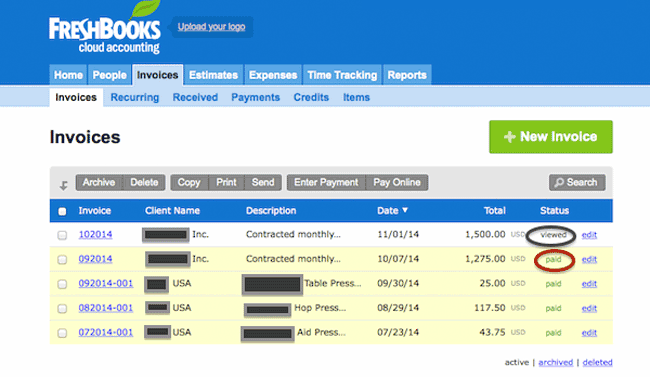
When I use to bill everything offline, I can’t tell you how many times I’d hear a client say, “Oh, we haven’t received your invoice.” This feature to me is like a vindicated ‘got-cha’ moment for when you have to deal with invoicing clients. Yes, clients do get busy and distracted, so I understand. This just keeps me from worrying about whether or not I should re-send something. If it’s been viewed, someone had to view it.
Once you’ve setup a client, entered their billing information, tracked it for a while, then it’s time to get paid. Sweet!
Payment gateways
Now here is where I’ll probably jump off the FreshBooks bandwagon and start walking. Not that I have any major complaints, but it has more to do with the frugal freelancer side of me and wanting to save money.
There are actually 13 different digital payment gateways that the cloud accounting system uses, so you’re bound to find at least 1 or 2 that mesh with your preferences:
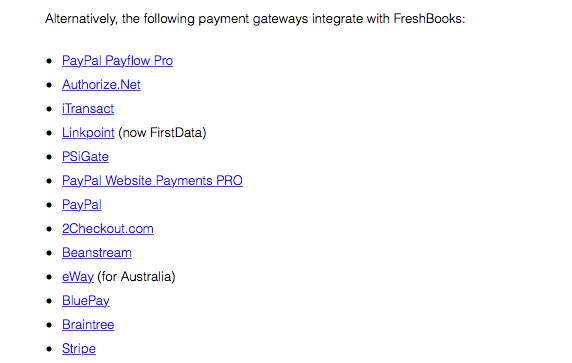
Although I use standard PayPal for all of my clients, using PayPal through FreshBooks as my payment gateway was something I chose NOT to do. For me, I chose to go the old-fashioned route and have my clients mail the checks to me. Before you wrinkle up your nose, let me explain why.
Yes, I do think digital billing is an awesome thing, but as a freelancer the fees for most of the payment gateways just cut way too deep into my profits.
Stripe and PayPal were the two choices I looked into when considering which to use. I’m already familiar with the standard PayPal fees, so I really wanted to see if Stripe would offer something different or cheaper, especially since I was a FreshBooks customer.
They do not.
Actually Stripe and PayPal are direct competitors in terms of fees and pricing. They both charge a fee of 2.5% and $.30 per transaction (if the transfer is between $3,000 to $10,000). And you still have to wait the allotted 3-5 business days before the funds are available in your account.
Why not get a PayPal merchant account, you might ask? Well, the PayPal merchant fees are still the 2.5% transaction fee whether it’s a personal or business account.
* I noticed that FreshBooks touted that their customers won’t have to pay such exorbitant fees if they use their business payment feature through PayPal, but I had to read the fine print. That feature applies to U.S. transactions only and is not for international customers. Both of my larger clients are international, so that feature is not an option nor a benefit to me.
I guess I really expected there to be a difference for FreshBooks clients with using these services. Something like a relaxed transaction fee, or a faster bank transfer perhaps. Like most other freelancers, I’m used to having to wait for PayPal before I can access my funds, but that’s MY choice. When you’re paying for a premium service, is it unreasonable to expect things to be a *little* different? (Yes, I know I’m not technically paying a premium for the FreshBooks service right now because I’m tracking less than 3 clients, but eventually I’ll have all of my clients on the system, so that’s why I don’t think it’s an unreasonable expectation).
When I first invoiced my clients through FreshBooks and had them pay via PayPal, the fees alone put such a huge dent in my profits that I decided to just digitally invoice them but have them snail mail the check to me. With this method, however, there are still a couple of issues:
– I have to wait (longer) to get paid, again.
– There’s a slight chance that the check could be lost in the mail.
Thankfully, I haven’t had to deal with the second issue, and I’d have to wait either way I went. As with everything else, you have to decide as a freelancer what’s more important to you. In this case, avoiding those crazy fees was very important to me right now. But I’m curious to know, what would you do in my case?
Tracking/Compatibility
Finally after I’ve received payment and able to close out the client’s statement, all I have to is then wait until the end of the year when I’ll compile everything in time for tax season.
With one press of a button (okay maybe two or three buttons), I can access my business reports. I can either print what I need or forward the information to my Quickbooks software or my business accountant. Here is one sample of a Payments report of a smaller client that shows me the amount of money I’ve received from them. You can produce reports that give you a date range, according to specified clients or even by whatever method you were paid.
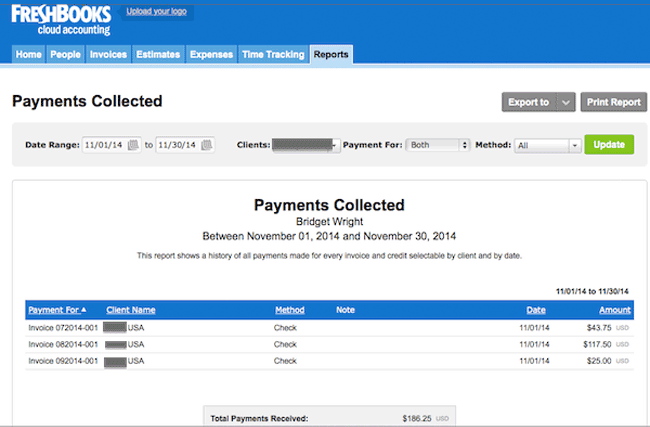
During any time of the year I can access reports and see what’s going on. I think this is a very helpful tool for freelancers who also work more with tangible products than services. For instance, you can see how your profits are doing in tracking ebook sales or any digitally delivered product and then determine whether or not to pull one product or promote a different one. You can also export your numbers to an Excel spreadsheet to further manage what you need.
Does the system work better with products or services? I think it all depends on the product or service. I referenced this CPA FreshBooks review from Brian Tankersley who suggested that it may be better suited for businesses who provide a service and bill by the hour or piece rate.
“The product does not support inventory tracking and valuation, and is best suited for service-based businesses.”
But, (in my opinion), since digital products don’t necessarily need ’tracking,’ you should be alright. However if you’re working with auction-styled products or you have an online store, this may be something you need to consider.
Conclusion
Would I suggest FreshBooks as a freelancer?
Absolutely!
The only thing that I would encourage freelancers to do is to have a look around the entire system, try it out for 30 days for free, ask questions from their help desk and read their blog and other professional reviews before you decide that it’s what you need.
Every freelancer is different and does business differently, but because of the nature of freelance work, I think this cloud accounting system is ideal and a practical solution. It’s a cost-efficient and productive way to free up your freelance time so you can concentrate more on working and growing your freelance business and less time on creating invoices and tracking down payment from clients. It definitely helps you to work faster, to appear more professional and also frees you up at those critical times when you need tax numbers and productivity reports right away.
Although I’ve only been using this system for a short period of time, I love it, but I would also like to know what you use for your freelance billing and tracking? How many clients do you have to manage within your tracking system? What alternate methods would you recommend?
______
Featured Image: [Flickr]
